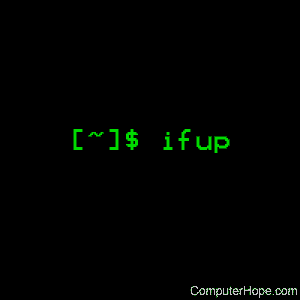Linux ifup, ifdown, and ifquery command

On some Unix-like operating systems, ifup activates a network interface, making it available to transmit and receive data.
The ifdown command disables a network interface, placing it in a state where it cannot transmit or receive data.
The ifquery command displays information about a network interface's configuration.
This page describes the GNU/Linux version of these commands.
Technical description
The ifup and ifdown commands can configure network interfaces based on interface definitions in the file /etc/network/interfaces.
The ifquery command is used to parse interface configuration data.
Syntax
ifup [-nv] [--no-act] [--verbose] [-i FILE|--interfaces=FILE]
[--allow CLASS] -a|IFACE...
ifup -h|--help
ifup -V|--version
ifdown [-nv] [--no-act] [--verbose] [-i FILE|--interfaces=FILE]
[--allow CLASS] -a|IFACE...
ifquery [-nv] [--no-act] [--verbose] [-i FILE|--interfaces=FILE]
[--allow CLASS] -a|IFACE...
ifquery -l|--list [-nv] [--no-act] [--verbose] [-i FILE|--interfaces=FILE]
[--allow CLASS] -a|IFACE...
Options
| -a, --all | If given to ifup, affect all interfaces marked auto. Interfaces are brought up in the order they are defined in /etc/network/interfaces. Combined with --allow, acts on all interfaces of a specified class instead. If given to ifdown, affect all defined interfaces. Interfaces are brought down in the order they are currently listed in the state file. Only interfaces defined in /etc/network/interfaces are brought down. |
| --force | Force configuration or deconfiguration of the interface. |
| -h, --help | Show summary of options. |
| --allow=CLASS | Only allow interfaces listed in an allow-CLASS line in /etc/network/interfaces to be acted upon. |
| -i FILE, --interfaces=FILE |
Read interface definitions from FILE instead of from /etc/network/interfaces. |
| -X PATTERN, --exclude=PATTERN |
Exclude interfaces from the list of interfaces to operate on by the PATTERN. PATTERN uses a shell glob syntax. If shell wildcards are not used, it must match the exact interface name. This option may be specified multiple times resulting in more than one pattern being excluded. |
| -o OPTION=VALUE | Set OPTION to VALUE as though it were in /etc/network/interfaces. |
| -n, --no-act | Don't configure any interfaces or run any "up" or "down" commands. |
| --no-mappings | Don't run any mappings. See interfaces for more information about the mapping feature. |
| --no-scripts | Don't run any scripts under /etc/network/if-*.d/ |
| -V, --version | Show Copyright and version information. |
| -v, --verbose | Show commands as they are executed. |
| -l, --list | For ifquery, list all the interfaces which match the specified class. If no class specified, prints all the interfaces listed as auto. |
Files
| /etc/network/interfaces | Definitions of network interfaces. |
| /run/network/ifstate | Current state of network interfaces. |
Known limitations
The program keeps records of whether network interfaces are up or down. Under exceptional circumstances, these records can become inconsistent with the real states of the interfaces. For example, an interface that was brought up using ifup and later deconfigured using ifconfig is still recorded as up. To fix this, you can use the --force option to force ifup or ifdown to run configuration or deconfiguration commands despite what it considers the current state of the interface to be.
The file /run/network/ifstate must be writable for ifup or ifdown to work properly. If that location is not writable (for example, because the root filesystem is mounted read-only for system recovery), then /run/network/ifstate should be made a symbolic link to a writable location. If that is not possible, then you can use the --force option to run configuration or deconfiguration commands without updating the file.
Note that the program does not run automatically: ifup alone does not bring up interfaces that appear as a result of hardware being installed, and ifdown alone does not bring down interfaces that disappear as a result of hardware being removed. To automate the configuration of network interfaces, you need to install other packages, such as udev or ifplugd.
Examples
ifup -a
Bring up all the interfaces defined with auto in /etc/network/interfaces.
ifup eth0
Bring up interface eth0.
ifup eth0=home
Bring up interface eth0 as logical interface home.
ifdown -a
Bring down all interfaces that are currently up.
ifquery -l
Print names of all interfaces specified with the auto keyword.
ifquery -l --allow=hotplug
Print names of all interfaces specified with the allow-hotplug keyword.
ifquery eth0
Display the interface options as specified in the ifupdown configuration. Each key-value pair is printed out on individual line using ": " as separator.
Related commands
ifconfig — View or modify the configuration of network interfaces.
